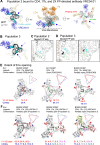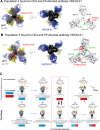Conformational trajectory of the HIV-1 fusion peptide during CD4-induced envelope opening
- PMID: 40382314
- PMCID: PMC12085566
- DOI: 10.1038/s41467-025-59721-2
Conformational trajectory of the HIV-1 fusion peptide during CD4-induced envelope opening
Abstract
The hydrophobic fusion peptide (FP), a critical component of the HIV-1 entry machinery, is located at the N terminus of the envelope (Env) gp41 subunit. The receptor-binding gp120 subunit of Env forms a heterodimer with gp41. The gp120/gp41 heterodimer assembles into a homotrimer, in which FP is accessible for antibody binding. Env conformational changes or "opening" that follow receptor binding result in FP relocating to a newly formed interprotomer pocket at the gp41-gp120 interface where it is sterically inaccessible to antibodies. The mechanistic steps connecting the entry-related transition of antibody accessible-to-inaccessible FP configurations remain unresolved. Here, using SOSIP-stabilized Env ectodomains, we visualize that the FP remains accessible for antibody binding despite substantial receptor-induced Env opening. We delineate stepwise Env opening from its closed state to a functional CD4-bound symmetrically open Env in which we show that FP was accessible for antibody binding. We define downstream re-organizations that lead to the formation of a gp120/gp41 cavity into which the FP buries to become inaccessible for antibody binding. These findings improve our understanding of HIV-1 entry and delineate the entry-related conformational trajectory of a key site of HIV vulnerability to neutralizing antibody.
© 2025. The Author(s).
Conflict of interest statement
Competing interests: The authors declare the following competing interests: B.T. and P.A. have applied for patents on HIV-1 Envelope modifications related to this work. The other authors declare no competing interest.
Figures





Update of
-
Conformational trajectory of the HIV-1 fusion peptide during CD4-induced envelope opening.bioRxiv [Preprint]. 2024 Sep 15:2024.09.14.613076. doi: 10.1101/2024.09.14.613076. bioRxiv. 2024. Update in: Nat Commun. 2025 May 17;16(1):4595. doi: 10.1038/s41467-025-59721-2. PMID: 39314380 Free PMC article. Updated. Preprint.
Similar articles
-
Conformational trajectory of the HIV-1 fusion peptide during CD4-induced envelope opening.bioRxiv [Preprint]. 2024 Sep 15:2024.09.14.613076. doi: 10.1101/2024.09.14.613076. bioRxiv. 2024. Update in: Nat Commun. 2025 May 17;16(1):4595. doi: 10.1038/s41467-025-59721-2. PMID: 39314380 Free PMC article. Updated. Preprint.
-
Inducible cell lines producing replication-defective human immunodeficiency virus particles containing envelope glycoproteins stabilized in a pretriggered conformation.J Virol. 2024 Dec 17;98(12):e0172024. doi: 10.1128/jvi.01720-24. Epub 2024 Nov 7. J Virol. 2024. PMID: 39508605 Free PMC article.
-
HIV-1 gp41 Residues Modulate CD4-Induced Conformational Changes in the Envelope Glycoprotein and Evolution of a Relaxed Conformation of gp120.J Virol. 2018 Jul 31;92(16):e00583-18. doi: 10.1128/JVI.00583-18. Print 2018 Aug 15. J Virol. 2018. PMID: 29875245 Free PMC article.
-
Quaternary Interaction of the HIV-1 Envelope Trimer with CD4 and Neutralizing Antibodies.Viruses. 2021 Jul 20;13(7):1405. doi: 10.3390/v13071405. Viruses. 2021. PMID: 34372611 Free PMC article. Review.
-
HIV Genome-Wide Protein Associations: a Review of 30 Years of Research.Microbiol Mol Biol Rev. 2016 Jun 29;80(3):679-731. doi: 10.1128/MMBR.00065-15. Print 2016 Sep. Microbiol Mol Biol Rev. 2016. PMID: 27357278 Free PMC article.
References
-
- Zhao, M. et al. Insertion and anchoring of the HIV-1 fusion peptide into a complex membrane mimicking the human T-cell. J. Phys. Chem. B128, 12710–12727 (2024). - PubMed
MeSH terms
Substances
Grants and funding
LinkOut - more resources
Full Text Sources
Research Materials

